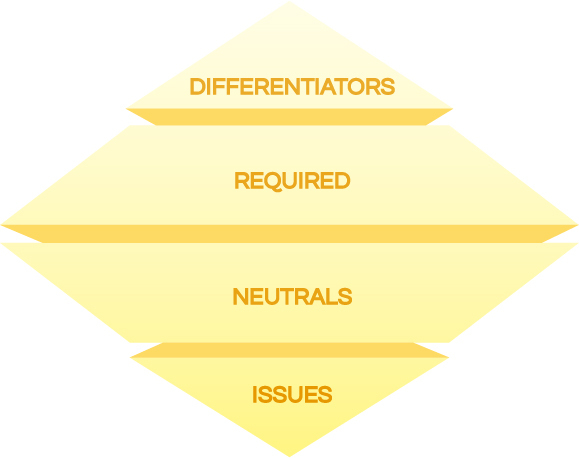Over the past 10 years, the legal industry has finally started to embrace innovative, customer-centric marketing tactics and strategies. For a long time, however, firms have relied on the strength of their partners and personal relationships to grow and drive business. But times are changing. There are more firms in the US than ever before and the competitive landscape is continuing to grow. However, with the advent of review sites, alternative fee structures, automation, and alternative legal service providers, firms are faced with a tremendous challenge.
Today, we’re seeing firms struggle to stand out as dominant forces where neither prestige nor competitive rates can ensure continued business. Corporations and individuals are looking for more from firms. Whereat one point, simply good counsel was enough, now they are looking for firms who align with their goals, missions, and strategy to make them look heroic.
This is where your brand comes into play. And before the naysayers jump in, yes your firm is a business and a star partner cannot carry the ship alone. At least not in 2020. At a time where differentiation is critical, what we’re still seeing is generic, copy-cat websites, and jargon-filled taglines that fall flat at the feet of new clients. With all this in mind, we’re going to take a look at the state of law firm marketing, the importance of communication and data collection, metrics to gauge your ROI, and automation tools that will make your marketing process a little smoother.
State of Law Firm Marketing
 In 2013, the legal services industry generated 256.66 billion dollars in revenue. In 2018, this revenue increased to approximately 288 billion. That is a lot of money. Although there is a huge opportunity in the legal market, law firms are not setting themselves up in a successful way to gain those clients.
In 2013, the legal services industry generated 256.66 billion dollars in revenue. In 2018, this revenue increased to approximately 288 billion. That is a lot of money. Although there is a huge opportunity in the legal market, law firms are not setting themselves up in a successful way to gain those clients.
So this leads to the question: how are firms handling their marketing?
A tech report done in 2019, noted that 47% of firms overall have a marketing budget. Additionally, those responsible for “handling” marketing still lies largely with the attorneys themselves. 59% of respondents, including 60% of solos, said attorneys perform these functions within the firm. A Bloomberg law study concluded that 62% of respondents say their firm is increasing its focus on marketing and business development and 63% of respondents say they expect their firm to increase its marketing and business development budget over the next two years.
This is a priority for many firms, and not only is it a priority to increase budgets in these sectors, but it has also become a priority in terms of where attorneys and firms are allocating their non-billable time.
In a legal trends report, 33% of the firms surveyed reported that they’re spending their non-billable time on business development efforts, so this means that it isn’t just the money investment going in, it’s the time investment as well. Even though firms are putting a lot of time, money, and effort into these activities, many firms are not tracking the output of their efforts. In the same legal trends report, 91% of firms can’t calculate a return on their advertising investments and 94% don’t know how much it costs them to acquire a new client.
Importance of Client Data Collection and Communication
Where are clients finding lawyers? What is the most beneficial way to promote your firm?
The top source for finding a lawyer is through referrals. So knowing this information, how can your firm improve referrals? Typically it’s by collecting feedback and understanding client experience. But then how do you collect that data? Do you formally ask in person? Do you make a dedicated phone call? Email survey?
If you’re thinking about the competition in the industry, simply asking and recording your clients' feedback can make a tremendous difference in either improving or maintaining your customer experience.
Not only is it important for your firm to collect feedback, but it is also important when you collect feedback too. Feedback is often being sought too late in the process. It’s either at the close of the matter, or sometimes during, but there is a majority of feedback that isn’t being collected at the beginning of representation. Why is it important to collect data at this time you may ask? Because you want to know why someone hired you in the first place. That’s how you can determine how to improve your marketing in the future, or how you can determine what factors are influencing your client's decisions.
One of the easiest methods to use to gauge client satisfaction is the net promoter score. It is one simple question, where on a scale from 0-10, where ten means “extremely likely", five means “neutral,” and zero means “not likely at all,” would you recommend your law firm to others? This simple question provides powerful insight, and with this information, you can figure out who your “promoters” are (the people who will most likely bring more matters to your firm), and the detractors (those who will not). Giving your clients this easy, straightforward type of survey will allow your firm to maintain relationships when they’re going well, or pivot and adjust when a client is unhappy before it’s too late (and in some cases prevent malpractice). In general, firms that focus on better client service have higher revenue growth, higher profits per attorney, and higher client retention.
Outside of cost, the factors that impact the likelihood of your firm being recommended are the ease of understanding case expectations, the personality or your attorneys, and responsiveness to email, phone, and text. Now that you just read that, what is the one trend that is consistent between these three things? Communication! Your firm's ability to understand who your client is, how they digest information and their expectations of you are all things that can be collected at the start and throughout the cycle of a matter. There are many things that are out of your control, but these factors are not.
Rate of Communication
In a study by BTI consulting, of the participating clients, 80% of clients expected immediate response to texts and emails. But don’t worry, immediate in this case meant between 1-2 hours. Unfortunately, when firms were evaluated, attorneys considered immediate to be more between 4-8 hours. Within that big of a time discrepancy, we know a few things can happen; clients can get anxious, impatient, and lessen the likelihood of referrals post-matter. The simple solution to this is setting communication expectations early on. Let your clients know what the average time for you to get back to them is so that they are not left wondering if you’re ignoring them. Although you may be juggling many clients at once, the goal is to treat each client like they’re your only client.
This responsiveness also can be translated into how successful your referral business is as well. When people are searching for representation, oftentimes, it is the firm that responds to their call or email first that wins the business. Not only are these firms setting the tone right off the bat, but they are also making the client feel prioritized which is a huge factor that leads to converting potential new clients into billable clients.
In an ABA Benchmark study on intake process, they found that 42% of the time law firms would take three or more days to reply to a voicemail or web-generated form from a prospective client. That is a long time! You spend time and money trying to collect new leads, yet when they come in, firms are still slow to capitalize by responding inefficiently. The same goes for responsiveness over the phone! 35% of callers to a law firm didn’t get to speak to a person and 50% of voice messages left were only returned within two days, while many weren’t returned at all.
Ethical Model Rules
All of this information on collecting client data and communication rates are great. But, there are two things when it comes to marketing that you cannot do. In simple terms, you cannot lie about your firm or your services (which should go without saying), and you cannot pressure prospective clients to hire you.
When it comes to advertising, you are by all means allowed to pay the reasonable costs of advertisements or communications, but you may not compensate, give or promise anything of value to a person for recommending the lawyer’s service.
Building Your Brand
To either create your brand or maintain an existing one, the first step starts with information. This information should be collected both internally and externally. For your potential new clients, you should be asking who your target audience is? What do you know about them? What trends can you identify? Internally speaking, you should be asking how your staff views the firm, where would they like the firm to be in the future? If what your staff says internally differs from what the outside world says, then you have identified a gap that must be bridged. This bridge will be created by your brand and if deployed effectively, will pave the way for expansion and growth.

Courtesy of DeSantis Breindel
Differentiators
In addition to identifying your brand, you must also identify the differentiators or pillars on which to build that brand. The underlying challenge with this is you must be able to distinguish between required characteristics (things that everyone in the industry must have), and those features that are specifically unique to you. The purpose of your brand, will not only serve as a differentiator but also as an anchor through times of turbulence. To determine what differentiates you from the rest of the field, you must dig deep, these core values go beyond the surface level and require industry-wide analysis and research to fully understand what your value proposition is compared to your competitors.
Requirements
Requirements are simply the elements that most legal brands have already. For example, “an experienced team,” or “unparalleled client service.” These things are the “obvious” essentials you need, but in 2020, they won’t set you apart.
Neutrals
Neutral factors are attributes that are not necessarily good or bad, and they will most like differ from firm-to-firm. Have you been operating for over 50 years? Is your firm woman-led? These things are all great, but when you ask if they were the tipping point for clients when they made their final decision between your firm and another, the answer is most likely not.
Issues
These issues (whether it’s one or many) encompass the challenges your firm faces that a brand may not be able to address. At a point, your brand will act as a stabilizer, but if you’re experiencing turmoil, like attorney turnover, malpractice, or even if you have a handful of clients who are unhappy, your brand can only go so far to counteract that. Make sure before making a push to identify your value proposition, you mitigate as many of these issues as possible.
Everything about your firm's brand is important. The way your attorneys present themselves, how your firm sounds as a whole in publicly distributed communications, how cohesive your strategy is, and your positioning across the rest of the industry.
One of the first things we discussed was data. In today’s world, a firm's ability to collect, process, and then utilize information will be the difference between a successful and unsuccessful firm.
Reporting
Marketing is important, there is no getting around that, but if you cannot create reports and analyze how your efforts are being translated in the real world, you’re wasting your time, not to mention your money.
The ability to group important reports, set security measures, track client data along with monitoring revenue are 2020 musts. Reporting gives you the ability to make better business decisions. It allows you to hone in on where you should be spending more or less of your funds, and it provides a deeper insight into how your firm is viewed both publicly and internally.
Metrics and KPIs your firm can use
For prospective new clients:
- Lead Source- Of different marketing portals (online, print, etc), you want to track which ones are bringing clients and the value of the matters
- Number of Potential New Clients
- Conversion Rate of PNCs
- Click-Through Rate of online advertisements
- Value Per Case
For current clients:
- Matter Reports
- Billable Hours
- Net Promoter Score
- CRM and Client Intake Software: ex. Centerbase
- Email Marketing: ex. Hubspot
- Social media management: ex. Hootsuite
- Virtual receptionist
- Live chat
- Appointment booking
- Surveys/NPS Sore
- Reports & referral tracking
The benefits of having all or even just one of these tools is priceless. Utilizing practice management software can allow you to automate the intake process. For example, if you have an intake form on your website, you can integrate that with your software so anytime a PNC fills it out, you are automatically notified on the back end. This streamlined communication process allows you to get to PNCs faster than your competitors.
As discussed earlier, it is important to know where your PNCs are coming from. Some software allows for marketing attribution that accomplishes just that. To go one step further, some programs allow you to customize conflict check reports to include only information that’s important to your firm. The ability to drill down on specific data is becoming more and more crucial, and utilizing tools that allow you to do that will drive your client experience and your referral numbers.


 In 2013, the legal services industry generated 256.66 billion dollars in revenue. In 2018, this revenue increased to approximately 288 billion. That is a lot of money. Although there is a huge opportunity in the legal market, law firms are not setting themselves up in a successful way to gain those clients.
In 2013, the legal services industry generated 256.66 billion dollars in revenue. In 2018, this revenue increased to approximately 288 billion. That is a lot of money. Although there is a huge opportunity in the legal market, law firms are not setting themselves up in a successful way to gain those clients. 


